As mentioned in an earlier blog, this is a useful phrase, with a respectable pedigree and it can certainly be applied to the snow we had last week. After two days of fine snow and wind ie blizzards, this pile of snow was found under the roof over our Pugin bedroom, luckily just as the thaw set in.
Snow Blizzards Hit Eastnor Castle
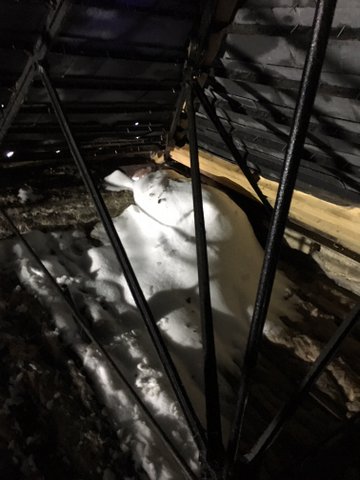
We do not have one of those vacuum cleaners that suck up water and so presumably are also fit for snow. Anyway, if we did, it would probably suck up the fibreglass insulation as well, so we use traditional methods: hand shovel and black plastic bags. Anthony Marriott, one of our house managers and the one who detected the tell-tale drip, and I lit the roof space with a bright lamp and set about scooping up the snow and bagging it up to be disposed of for melting outside. If it melts under the roof, it can bring down a ceiling or at least make a mess of the paintwork. An hour and a half later (there were other piles elsewhere) it was all gone, and we had managed not to step between any rafters and damage the ceiling below in a more forceful way.
The photograph not only shows the offending snow but also the cast-iron roof trusses designed by the castle architect, Robert Smirke. The slates rest on cast iron purlins and are held in place by nails. It is a system that has survived the test of time, but unfortunately, the seal between the slates or torching as described here, has long dropped off, and we have not replaced it, allowing, as an architect might say, the ingress of snow. If we had the wrong type of snow every winter, I would think about it.
James Hervey-Bathurst
4th March 2018
The heavy snow produced a magical and seasonal appearance to the landscape, and the lake froze over. We cleared the drive before anyone slipped off the road and drove into the yew hedge, which was already under a lot of pressure from the weight of snow, which, at least for the natural world, was definitely the “wrong kind of snow“.

Snow at Eastnor Castle
Sadly, our cedars and other confers suffered heavily as the weight of snow broke boughs off close to the trunk. All night we could hear cracks and crashes as they came down. Other trees, such as the magnolia in our garden, suffered too, but not as badly.

New Trees for Eastnor Castle
In a well-timed visit, however, Martin Gardner, Co-ordinator of the International Conifer Conservation Programme at the Royal Botanic Garden Edinburgh, appeared yesterday with a supply of young specimen trees from seeds taken from native trees under threat. They included firs from Turkey (Abies nordmanniana) and a critically endangered Notofagus Alessandrini from Chile. They will be very welcome additions to our stock and will be carefully planned out as soon as the snow clears.
On a different note, a team of men has been clearing the snow from the valleys on the roof to allow the water to run off unimpeded when the snow melts. In the case of the roof, it has been the right kind of snow as it is the powder kind that blows in between the slates and causes trouble to our interiors.
James Hervey-Bathurst
19th December 2017
Our lake is an important feature in the landscape and was made by blocking up two streams once the old house, Castleditch, was demolished in 1818. A few years ago, we had to restore the weir and did so with the help of English Heritage, now Historic England, and the Country Houses Foundation, but this time we have been on our own, as it were.
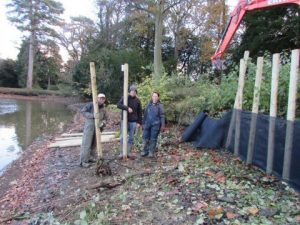
The first image shows Tony Mckenna and his team from AES Europe https://www.aeseurope.co.uk/ Corby, in the process of hanging netting along the south bank where wave action over the years has severely undermined the bank, causing soil, trees etc to fall into the lake and making the edge unstable. The AES system, also used by the National Trust, will encourage the growth of vegetation to stabilise the bank over the period when the netting is still in place and after a couple of years, we are assured, the bank will look quite natural. If it works, we will extend the protection to other affected areas.
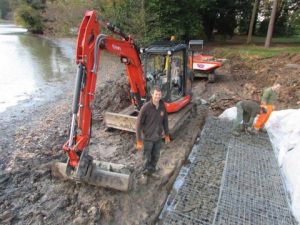
The second image shows Rob Shail and his team adopting a more structural approach using gabions to strengthen the all-important bund that blocks the valley in which the lake lies. This work is being done with guidance of a structural engineer, Mark Hayward, of Fairhurst https://www.wafairhurst.co.uk/ to comply with the requirements of the Reservoirs Act 1975. The bund has also been undermined and has had tree stumps threatening to weaken it further. When finished, we are told that the lake should be able to survive a once in 1000 years “event” ie a very big lot of rain, as we had on 19th July 2007 when it was a once in 250 years’ event with 150mm or 6” of rain.
It is good to know, though I may not be around to see it when it happens.
James Hervey-Bathurst
6th December 2016
Electricity first arrived at Eastnor in 1910 when a generator was installed where the Land Rover Experience centre is now. It was used to power 110-volt lighting circuits, some of which survived until a couple of years ago when we had the chandelier in the Pugin Gothic Drawing Room rewired, not before time, we were told. The old bulbs, with their robust tungsten filaments, produce some light and quite a bit of welcome heat, so they were still fit for purpose if supplemented by more modern lights at a lower level.
We have rewired gradually, introducing three-phase in the 1990s and a stand-by generator, acquired second hand from a local authority, to keep the lights on during power cuts. But the demand for power has risen, with multiple and simultaneous uses of hair driers, more by wedding guests than by my wife and daughters, and the installation of a new electric oven, a ten rack Rationale, in the catering kitchen. I admit I have also caught my younger children using an electric fire occasionally in their draughty playroom (my mother used to hide electric fires and reserve them for guest use only).

Our last distribution board has run out of capacity, so we are installing a new Hager model to meet ongoing needs. The image shows Justin Hill and Jason Blewitt working on the two-day job. The mains and generator supplies are switched off, of course, but there is a temporary generator to supply light and my laptop and office. Justin and his father, Michael, fitted the original distribution board when the three-phase came in. The house is unnaturally quiet, apart from the plaintive squeaking of the fire alarm system telling us the power is off. The emergency lighting has worked for the statutory time required and is now rather dim. I am using a head torch to access areas away from natural light. Most of the staff have a day off, though calls are being diverted to the Estate Office. It will be a relief to have the job done and to have a safer system with more capacity.
JH-B
5th February 2016
In the image, from left to right, are Peter Walker, Stephen Price and Robin Whittaker who have been previously involved in the Worcestershire County Archives, Robin having just retired as the County Archivist, and Hazel Lein, the archivist at Eastnor. The gentlemen, with guidance and assistance from Hazel, have just complete 5 years’ work, at a rate of about one day a month, sifting through and cataloguing deeds that cover among others, land, in the parishes of s of Stoulton, Bransford, Leigh, Castlemorton and Strensham, where our family owned land until it was mostly sold at the beginning of the last century. The reason given for the sale was that the houses and farms had suffered from underinvestment in previous 40 years partly as a result of the Agricultural Depression and probably also because the family diverted the money to other purposes and were not fit to let. They could also make more money by selling off the land to developers especially in the area of the new town of Malvern Link, hence the road names like Somers Park Avenue and Somers Road.
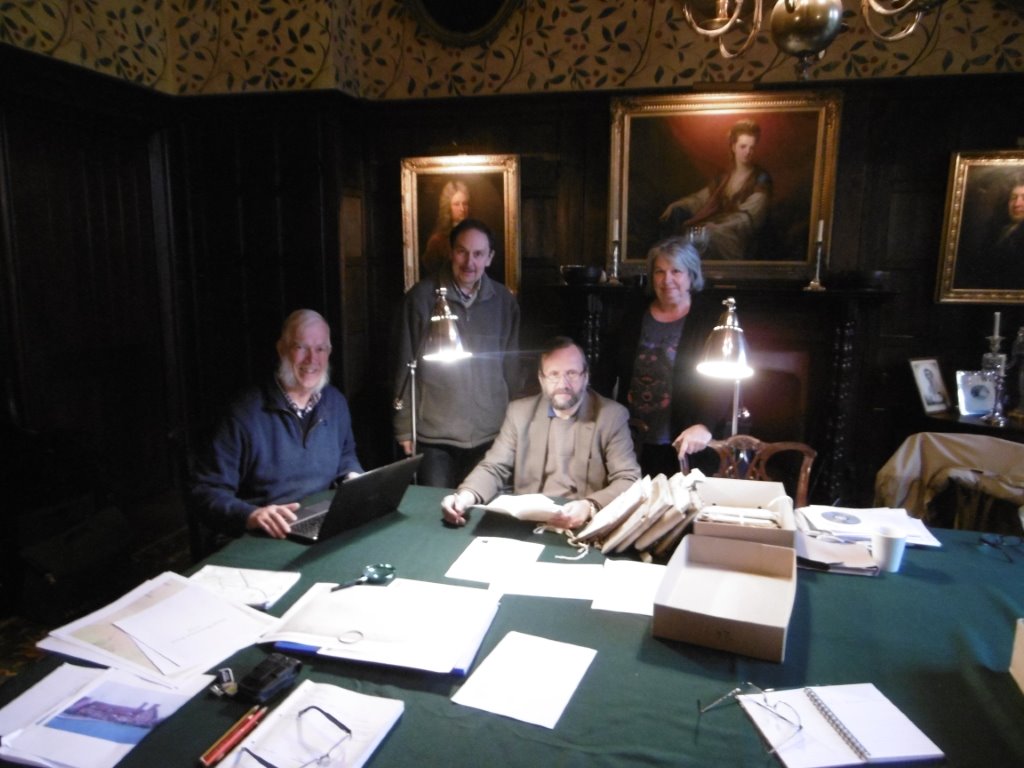
It has been a sometimes slow but for these historians a very exciting task. The original deeds that were still wrapped in the solicitor’s bundles had been placed in six large cupboards in the muniment room. Many of the deeds antedate our ownership of the properties concerned, as well as covering important manorial records. Some of the documents are mediaeval, most on vellum and often the lingua franca seems to be Latin, which Robin can read with ease. But he modestly asserts that that is quite normal for a man of his profession.
They have recorded 3500 items from 67 archive boxes. They have cleaned, sorted indexed and placed everyone in archive quality boxes. They have found deeds relating to various subjects such as houses in Worcester and Droitwich as well as land sold to build Malvern Link Station. There are records of the Worcester Yeomanry’s formation during the Napoleonic Wars, and include a note of a consignment of cutlasses being returned to the Tower of London, then an arsenal, because they were rusty. Attacking an invading Frenchman with a rusty weapon would clearly have been bad for our reputation and possibly not very effective.
Peter, Stephen & Robin have enjoyed the task and been genuinely excited by the chance to view documents that have not seen the light of day for several hundred years. We could not have had a more eminent, knowledgeable, group of experts. Hazel is thrilled to see the project complete, but will miss the fun and the ad hoc tutorials! A note of what we hold will go to the County Archive, and we will allow scholars and other interested parties to inspect the papers on certain conditions. We are very grateful to the team for completing the job.
James Hervey-Bathurst
January 2016
After our review of what has happened in the 2015 visitor season, when we had about 42,000 through the gates, we have decided to change the layout of our shop and ice cream parlour. Here is an image of Andy Rollins, Andy Thornber and Bob Hayter from our Works Department at the slightly easier demolition stage of the project. They are fitting the work in around the refurbishment of the old Post Office, an attractive building with a thatched roof, at the main entrance to the Castle and Grounds. The new floors went in earlier this week, so there is no access while they are setting.
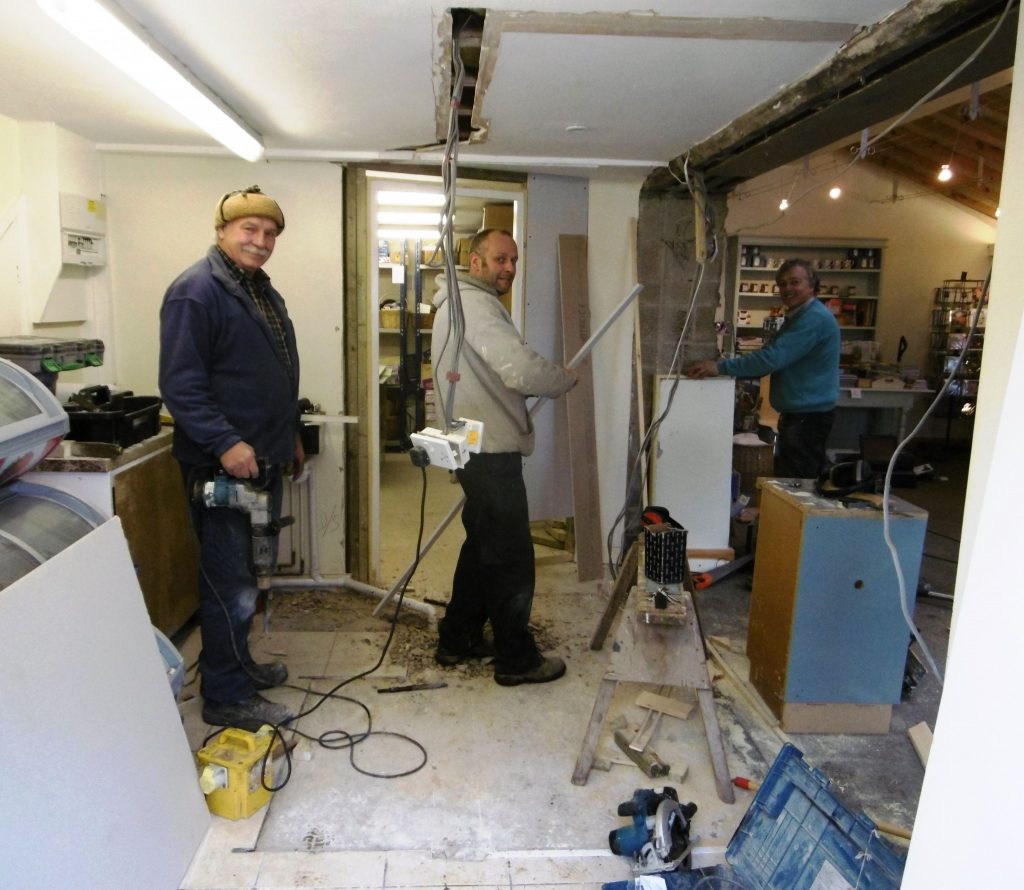
Buying ice creams and souvenirs is an essential part of the visitor experience, and it now makes sense to combine them by knocking down the temporary partition wall between the two areas. The aim will be to encourage a flow of visitors between the two outlets and streamline the operation while making it easier for visitors to access.
Ice creams sell in almost any weather, but the right sort of sun certainly helps. The parlour is conveniently situated on the way to the playground and to the tea room. We staff it with young people keen for seasonal work. Our shop, which is run by Rachel, who otherwise helps with our in-house catering, is a more complicated business, but not weather dependent. We stock some Eastnor Castle branded souvenirs, post cards and other gifts. At one time we also included remaindered books, which sold rather well, but I think Amazon may have taken that market.
We re-open at Easter when these adjustments will be put to the test. I am confident there will be an improvement, and it will not just be attributable to the weather.
James Hervey-Bathurst
December 2015
The Ransomes 6 Nominal horse power general purpose agricultural engine came into our collection in 1974 after a life working in an agricultural and equine feed mill in Dublin. It had lost its original livery and received a coat of blue paint, though the Ransomes transfer with the company crest is still visible at the front end of the boiler barrel. But it was in remarkably good condition and complete with all its fittings, so we were able to steam it almost as soon as it came home. We transferred the number DCJ 15 to it from a Fordson tractor in the collection of the late William (“Bill”) Thomas Jones, who part owned the engine and recovered it from Ireland with his low loader.
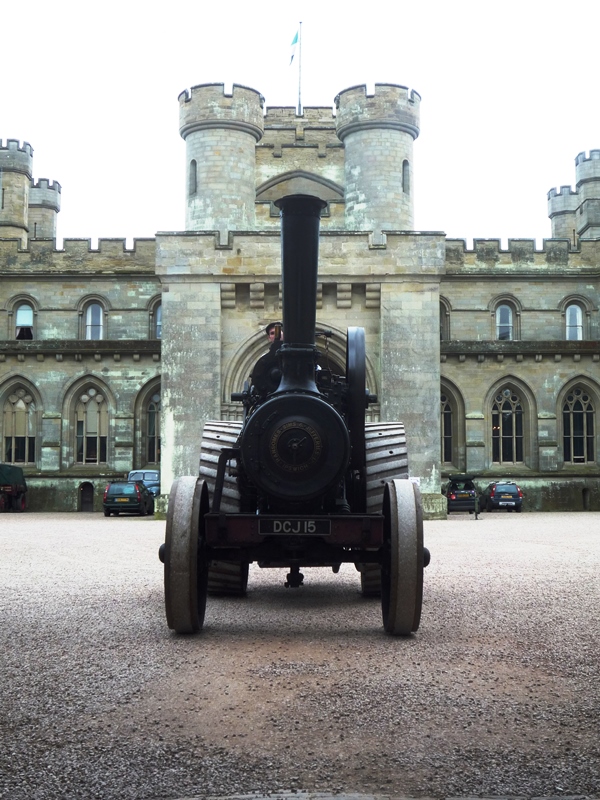
As the images show, the Ransomes, which left the works in 1915 with the number 26839, has not been restored much in the last 40 years. It retains its steel wheels and so looks very much as it did in its earlier life. As a result, it is much appreciated at steam rallies, where other engines are often glistening with new paint and shiny brass.
We have used the engine to drive a circular saw and a threshing machine as it is very well governed with a Gardner governor.( According to Wikipedia, the Gardner Governor Company, founded by Robert Gardner, introduced the first effective speed controls for steam engines in 1859 with an innovation, known as the flyball governor). It makes a great noise when at work, but is slow on the road due to the lack of rubber tyres and springs.
At our steam events, it is a popular other half of a tug of war, though the visitors’ team find the courtyard gravel quite a disadvantage, but we will see how they get on this Sunday & Monday when the Ransomes will be out and on display in steam.
James Hervey-Bathurst
22nd May 2015
This is not a newly discovered adventure of the fictional schoolboy at Linbury Court preparatory school, as might have been written by the late Anthony Buckeridge, but a reference to one of our two surviving Victorian water closets supplied by George Jennings. In the first image Mick Woolley, our versatile contract plumber, and Bob Hayter, our also versatile joiner who is a member of our Works Department, stand over the WC after replacing a leaking valve and replacing perforated lead piping, which was allowing wastewater to leak through the ceiling of the Red Hall below.
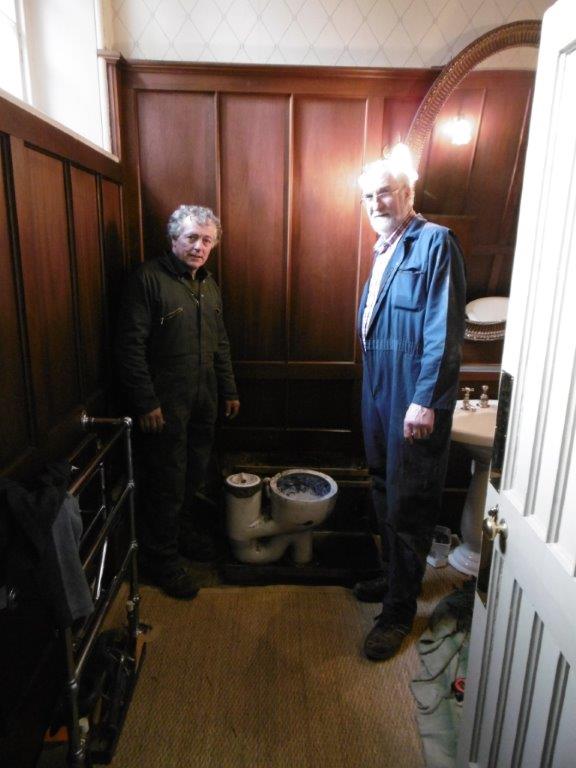
George Jennings is best known for supplying the WC’s for the Great Exhibition in the Crystal Palace in Kensington Gardens in 1851, where they were the first public conveniences. Over 800,000 people paid a penny to use them and started the expression “spend a penny”. He was a successful sanitary engineer, and his family firm lasted until 1967.
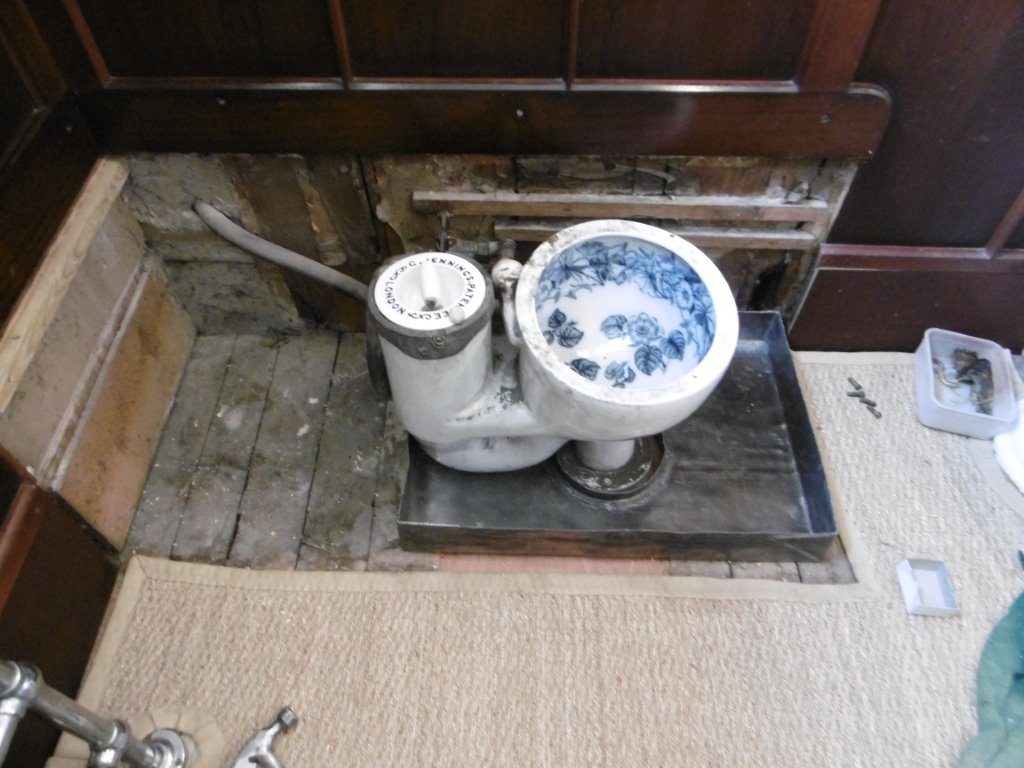
In the second image, a more detailed view of the WC is shown, with the patent valve on the left.
This one had a leather diaphragm, which had hardened over the years, cracked and started leaking water into the pan. After the valve was removed, I sent the valve for restoration to Phil Jefferies of Heritage Foot Pumps, Stafford, a business which has now sadly closed. In the meantime, Mick & Bob managed to find the leaking waste pipe, removed it after some difficulty and replace it with a modern plastic one. I was surprised that an original lead pipe would have leaked, but the final image shows the holes, which Mick blames on the use of modern cleaning agents.
The Jennings with its fine mahogany surround is now back in working order, a tribute to a fine Victorian sanitary engineer and to the skill and persistence of Mick & Bob. It remains an attractive-and convenient-feature of the castle.
We have been dealing with Mintons for some time as they are a relatively local firm who supply us
with soft drinks etc.. In this image, Russell Grimmer is seen as he delivers a few cases of Belvoir Fruit Farms ‘Elderflower Pressé for consumption at weddings and other events, where it is a very popular alternative to Coca Cola and mineral water.

Belvoir Elderflower Pressé was developed by my late father-in-law about 30 years ago when we successfully tried to reproduce an elderflower drink he had been given as a child. Somehow, the old recipe had survived and after the family had been drafted into harvesting elderflower from the hedges and woods around Belvoir, the cordial was produced. He and my mother-in-law then brewed up enough to allow them to take it to numerous country fairs so it could be tested on members of the public, who were encouraged to comment on the taste so that it could be refined to satisfy the palate of the majority before production began in earnest in redundant farm buildings.
My brother-in-law now runs the business and he has expanded it considerably, adding new products and markets. We make a very modest contribution to his sales efforts by supplying Belvoir Fruit Farms’ products at Eastnor, and my younger daughters are looking forward to selling some at our Chilli Festival on 3rd & 4th May this year.
It is tempting not to throw things away, whatever the size of your house, and the problem is worse if your house is big and has extensive cellars. Earlier this week, I was thinking about a bit of clearing out in the cellars when I came across the floor polisher shown in the image – I refer to the wooden device, not my daughter, who is seen trying to make it work.
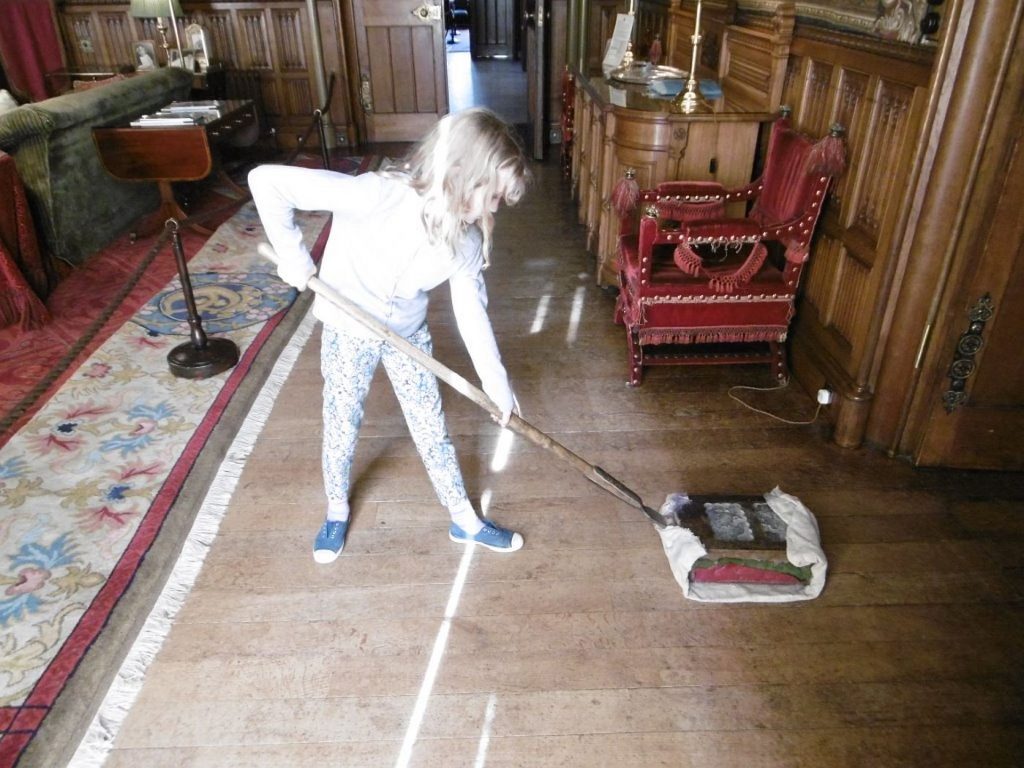
It consists of a wooden box filled with lead and cloaked in material, which on investigation proved to be two layers of felt and then a roughly applied piece of old blanked, which perhaps experience in use had shown either to be easier to push and pull or more effective in doing the job. The device had survived quite well despite attention from woodworm and moth, though the moth had clearly given up at an early stage after finding the material too dirty.
I have cleaned and polished the lead-filled box and put the polisher for others to try in the Gothic Drawing Room, where there is a bit of exposed oak flooring. I have also made a Risk Assessment, as you must, and concluded that the risk of anyone injuring him or herself or damaging any pieces of furniture is low, but anyone who manages to move it more than twice will appreciate how hard the physical labour of cleaning used to be. At the same time, there is a chance that we will get our floor polished, in a small area, rather in the same way as those with safari parks have some of their animals fed by selling packets of feed to visitors to give out.
James H-B 29th August
Jools Holland returned to play in the Park last Saturday. His guest stars included Marc Almond, Mel C and Ruby Turner. Ticket sales accelerated as the date approached, and the weather kept fine. We now have a Public Entertainment Licence for events for up to 10,000 people, so the process of arranging it all was made much easier.

The evening started well as everyone arrived well in advance and the access and parking arrangements worked better than in the past. Jools himself was certainly on time and played with great brilliance, energy and enthusiasm. The ominous black cloud that appeared over the site deposited some rain, but luckily not too much. By the time I had gone back to the house to collect umbrellas, it had stopped. If I had not gone, no doubt it would have continued.
A gap was left in front of the stage, and once the music started, it quickly filled up. Grass is not the ideal dancing surface, though better than mud, but that did not stop the evening developing into a happy giant disco. As the acts warmed up, so the crush increased, and everyone seemed to have a great time.
Jools commented afterwards that Eastnor had provided a great audience, which must be what the performers want. They certainly gave their best, and we look forward to having them back before too long.
JH-B 1 August 2014
I would like to think that Eastnor Castle, our grounds and children’s playground were enough to keep our visitors happy and generally, they are, but on the more popular days at Bank Holidays, we feel we should do more and so we hire the services of Jem Maynard Watts and his colleagues Thomas Trilby.
As the visitors arrive in the car park, Jem appears on stilts and inappropriate clothing to greet them. He may briefly convince children that he is a giant resident in the Castle, but mostly he chats to everyone and makes them laugh, important if there is a queue. As the day progresses, he comes down a peg and bicycles around on a penny-farthing, of modern manufacture, unfortunately, but nevertheless impressive.
At the end of the day, when there has been a competition, Jem draws the prize, but not before he has had a good juggle with one of his colleagues, an unexpected bonus for the audience and some compensation for the competitors who did not win ie. all but one. He always gets a great round of applause, partly, of course, because he is a great entertainer. He has a great sense of humour and is keenly interested to know how he is being received by the crowd. He also tells us what the visitors tell him about their visit, where they have come from etc… Jem helps create a party atmosphere around the castle, and we love having him.
Recently, a few sandstone blocks on two of our towers have been spalling, which involves losing the outside layer of stone in a thin flake, which then falls dangerously to the ground without warning, a real hazard for anyone too close without a hard hat. We roped the areas off in case of any further events and called Wallwalkers to the rescue as a cherry picker would not have worked and scaffolding was not necessary, or economic for the amount of work involved. Wallwalkers, a local firm had access to the top of the two towers and were able to secure their abseiling ropes without difficulty. They then dropped over the side, as it were, and tackled each damaged stone in turn, so there were no loose pieces left. Even though the top of the tower projects from the wall, they were able to dislodge all the loose pieces quite easily. In the image, a damaged (discoloured) stone is seen to the left of the Wallwalker as he works his way down, fortunately on a sunny day.
The cause of the problem is the ingress of rain into the gaps between the blocks where the lime mortar has failed. The stone then gets wet and is damaged by frost, of which there has been plenty last year. The solution is to re-point where we need to, and the next stage is to make a photographic survey of all the stonework to see where we need to go and estimate what it will cost. As the gaps between the blocks are only about 1mm, the material we use will have to be carefully selected. We will also have to make flaunching repairs to the tops of the stones below those where the flakes have come off as they will otherwise be vulnerable to water ingress from the top edge where they are now exposed.
After all we have spent on the roof and parapets it is annoying now to find more work, even if we do not have to re-point everywhere. At least business is picking up and bookings are better for 2014…
JH-B 23rd January 2014
After I wrote about “Smirke Revisited”, various works of art duly arrived at Eastnor on loan from the Lonsdale collection, and we had the excitement of unpacking and unwrapping the items as they were delivered. I image my ancestors had the same experience as their purchases arrived from the Grand Tour, or its mid-19th century equivalent, though I suspect they would have been more in a supervisory capacity rather than in a hands-on role as I was and I doubt that so much of high quality would ever have arrived at one time.
We then had the challenge of displaying it all. I had done some planning and bought in a number of heavy hooks and chain from Frank B Scragg of Birmingham. Our first job was to fix cast iron hooks to the backs of the frames as the Lowther picture hanging system was different from ours. We then suspended the new chains from existing rails, after moving our own pictures to one side to make room for the distinguished visitors. We then offered up the new paintings to see what they looked like. On the whole, they looked excellent.
In the first image, David Littlewood, our Business Manager, and Anthony Marriott, one of our house managers, have just finished helping me hang a painting of Lowther Castle from the park by Turner. Obviously a very good painting, it was nevertheless hard to see without a picture light, so we asked Tom Oates from Chelsea Lighting Design to produce a light that would exactly illuminate it after I had sent all the dimensions. Then the second image shows the Turner in the middle, duly lit after Tom and two colleagues came down and did the job. The effect is dramatic. The painting is now the highlight of the Dining Room, if not the whole display, and the light exactly covers all the canvas and frame, whereas to light the top of the painting-and overheat the canvas in the process. We have also had Tom fit new lights to six other paintings on his visit.
I hope our visitors will appreciate the new display when we re-open to the public at Easter in 2014. Meanwhile, I am glad the bulbs have a predicted life of 4000 hours!
JH-B 17th November 2013
We sweep our chimneys every year after the winter, but often not much soot comes out. After a chimney fire about 15 years ago, I assumed we were using drier wood and less soot was being generated, but I was wrong. The first image shows my view of the house from halfway around the lake when I saw black smoke emerging in huge volumes from the Great Hall chimney. As I was without a mobile telephone (there would probably have been no signal anyway), I ran, or more like jogged, back as fast as I could to raise the alarm in case the fire was not obvious to the people inside.
I found that the Fire Brigade was already on its way, and the firemen soon started rodding the chimney when they arrived. It is probably at least 70ft high, and so extra rods had to be summoned from another appliance, along with an electronic heat detector to check for any hot spots on the walls through which the chimney passed. There was some smoke in the adjacent areas, but, strangely, not enough to set off the smoke alarms.
The rodding worked up to a point, but the fire roared on, so we decided to pour water down the chimney. After a brief, but tense, search for the key to the door to the Keep roof, we emptied numerous buckets of water down the chimney, though most of the contents came straight back in the form of steam. Eventually, a fire hose reached us, and the fire was quenched, without doing any obvious damage to the interior decoration of the house. The second image gives an idea of the height of the chimney, though sadly the extended ladder could not get close enough to the house to be useful.
On advice from the Fire Officer in charge, we have now had the chimney inspected with a CCTV camera. We have found the ledge where the soot accumulated, away from the sweeping brushes, and will almost certainly have the chimney lined to protect the fabric of the house in case of another fire. It was all quite dramatic, but the efficiency of the Fire Brigade was re-assuring. In future, we will have to use a professional firm of chimney sweeps and have camera inspections on a regular basis.
JH-B 19th December 2013
After I wrote about “Smirke Revisited”, various works of art duly arrived at Eastnor on loan from the Lonsdale collection, and we had the excitement of unpacking and unwrapping the items as they were delivered. I image my ancestors had the same experience as their purchases arrived from the Grand Tour, or its mid-19th century equivalent, though I suspect they would have been more in a supervisory capacity rather than in a hands-on role as I was and I doubt that so much of high quality would ever have arrived at one time.
We then had the challenge of displaying it all. I had done some planning and bought in a quantity of heavy hooks and chain from Frank B Scragg of Birmingham. Our first job was to fix cast iron hooks to the backs of the frames as the Lowther picture hanging system was different from ours. We then suspended the new chains from existing rails, after moving our own pictures to one side to make room for the distinguished visitors. We then offered up the new paintings to see what they looked like. On the whole, they looked excellent.
In the first image, David Littlewood, our Business Manager, and Anthony Marriott, one of our house managers, have just finished helping me hang a painting of Lowther Castle from the park by Turner. Obviously a very good painting, it was nevertheless hard to see without a picture light, so we asked Tom Oates from Chelsea Lighting Design to produce a light that would exactly illuminate it after I had sent all the dimensions. Then the second image shows the Turner in the middle, duly lit after Tom and two colleagues came down and did the job. The effect is dramatic. The painting is now the highlight of the Dining Room, if not the whole display, and the light exactly covers all the canvas and frame, whereas our old-fashioned lights used just to light the top of the painting-and overheat the canvas in the process. We have also had Tom fit new lights to six other paintings on his visit.
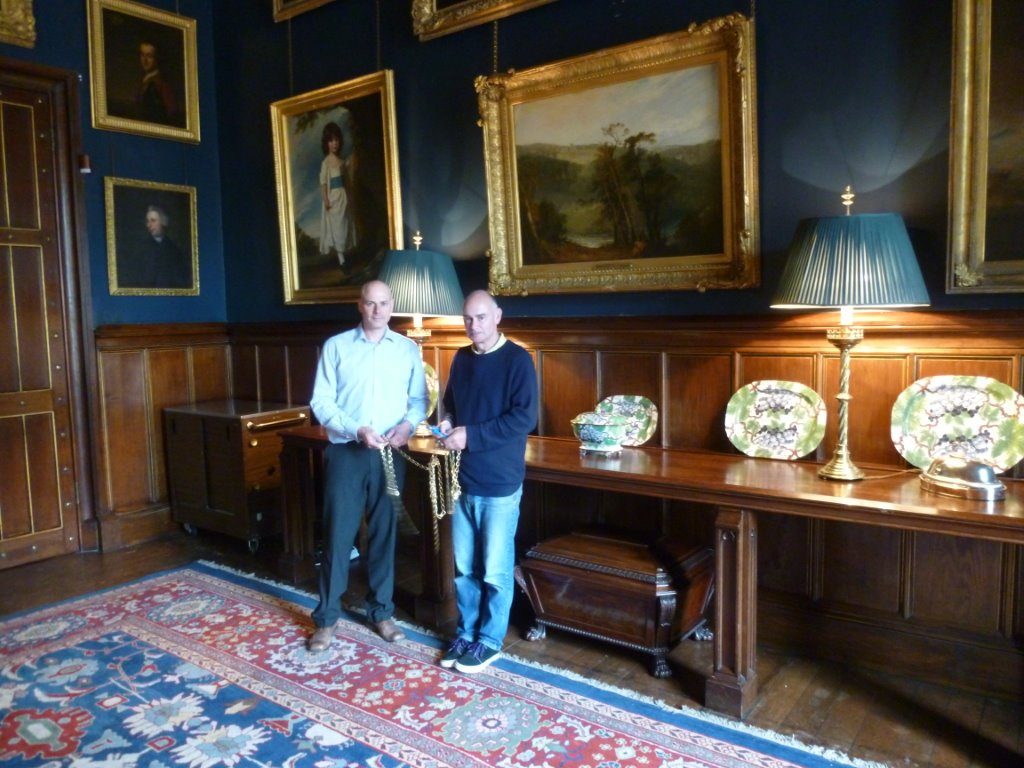
I hope our visitors will appreciate the new display when we re-open to the public at Easter in 2014. Meanwhile, I am glad the bulbs have a predicted life of 4000 hours!
JH-B 17th November 2013
In an alley off the south end of Ledbury High Street are the discreet premises of Tilley Printing. It is a Victorian establishment, now owned and run by Martin Clark, and he supplies us with printed writing paper for our guest bedrooms and other materials from time to time, including invitation cards to my 21st birthday party, my brother’s and my eldest daughters (sadly, not repeat business).
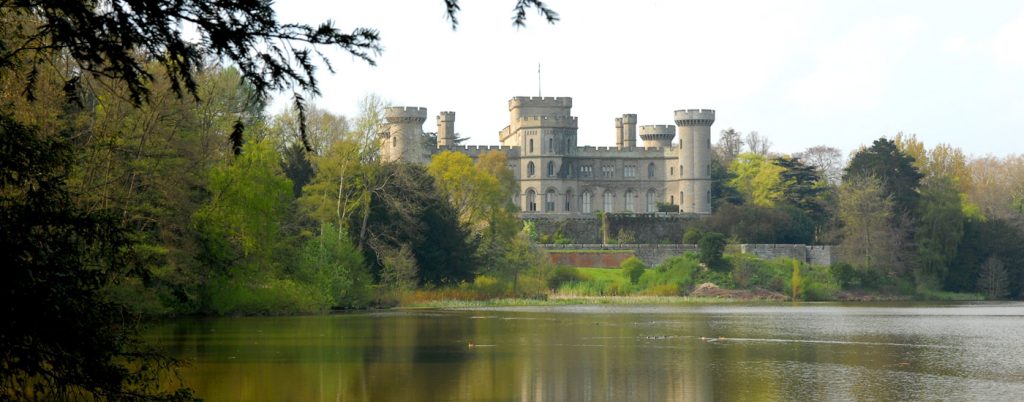
Although Martin is seen standing next to a relatively modern machine, he also uses an Albion Press, manufacturer by A Wilson & Sons, London, from about 1850 and a Wharfedale Printing Machine by Payne & Sons, Otley, one of the machines which is said to have transformed the printing industry in the second half of the nineteenth century. The Tilley machine dates from about 1895, according to Martin, and is still driven by a belt off the original line shafting, which itself is now driven by an electric motor, a replacement for a paraffin engine and before that a steam engine. (The covered-over hole for its chimney is still evident in the roof).
Tilley Printing was started in about 1870, when Luke Tilley, a local stationer and photographer, took over the business from a Mr Bayliss. It is open for business on weekdays, and is occasionally open at other times e.g. for Herefordshire Art Week. To secure its future, Martin has taken on an apprentice, Anneliese Appleby, a former art teacher. Her training is being sponsored by the Queen Elizabeth Scholarship Trust a charity of the Royal Warrant Holders Association.
We hope it all works out as we should like to continue using Tilley Printing and its perfectly good, but old machines for as long as we can.
JH-B 14th September 2014
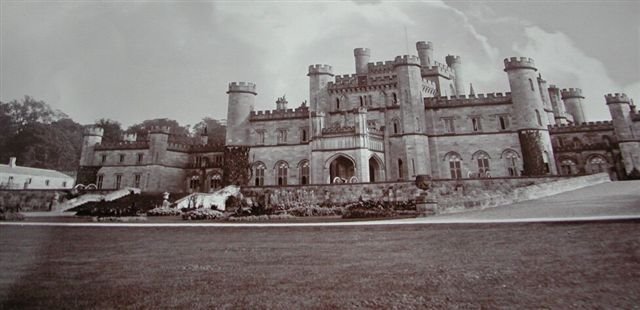
The image shows Lowther Castle, designed by Robert Smirke for the Earl of Lonsdale and started in 1805, seven years before Eastnor. When my ancestor, Lord Somers, was considering which architect to commission for his own mansion in the style of a mediaeval castle, Smirke was an obvious candidate, and Lord Lonsdale provided a positive reference, recommending Smirke and saying he did not suffer “from the faults of other architects”, without stating what they might be, though overrunning the budget was likely to be one of them. In fact, Smirke had tendered £140,000, but only spent £110,000 to build Lowther. Lord Lonsdale was so impressed that he nevertheless gave Smirke the full contract sum.
Sadly, Lowther has only survived as a shell as many of its contents were sold in the 1950’s and the house largely dismantled, a fate suffered by over one thousand historic houses in the UK during that difficult period. But many of the best works of art were kept by the family and moved to another house on the estate, where they were available to view by appointment. The good news is that a charitable trust, is now building a gallery on the site of the castle where much of the Lonsdale collection will be displayed to visitors.
As the family would like to display some of the paintings and furniture before the gallery opens next year, and it is an unusual chance for us to work with another estate, we have agreed with the Lonsdale trustees to have a temporary display at Eastnor. A number of objects are due to arrive next week and will be on show amongst the paintings and other works of art in the rooms visited by the public. They will certainly add to the visitor experience, though it will not be on the scale of the great “Houghton Revisited” exhibition in Norfolk, which has been such a great success: see www.houghtonrevisited.com But it will enhance our own collection for the next season, and I hope the works of art will appreciate being back in a Smirke castle after a seventy year break. I must just make sure I do not get too fond of them while they are here…
JH-B 6th September 2013
We have had a number of fashion shoots in the past. The first was with Kutchinsky with the famous Norman Parkinson, followed by one for Tatler and then a German lingerie company (which required extra heating). Luckily, the Miss Selfridge team came to Eastnor during a warm week and were able to shoot inside and out, without any special arrangements having to be made.
One image shows Katie Pearson and Nicola St Louis sorting out some of the 8 rails of clothes, referred to generically as “garments”, before taking them back to London for the official launch of the latest catalogue. Over sixty images were saved by Jackie Dixon, the photographer and a selection will eventually be offered in catalogue form and on line. They were able to use quite a number of areas in the house and grounds, but I do not expect it will be obvious that we are the location.
The other image shows the Octagon saloon converted into garment warehouse for the shoot. It is the ideal room for it as it is sparsely furnished and used for breakfasts, lunches, dancing and drinking and corporate off-site meetings. Until 1939, it was used by my grandparents as their drawing room as my grandmother did not like the Pugin Gothic Drawing room next door. It has a carpet which was re-made new in China, a copy of the Indian original made in Amritsar for the room in the 19th century, and a bust of my father, who used to receive Land Rover guests there before they set up their main centre in the old kitchen gardens: / he would have enjoyed the latest spectacle.
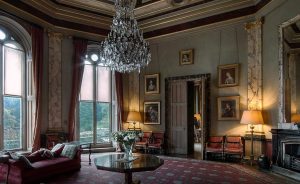
We have loved having Miss Selfridge here, and I am only sorry my wife and daughters have been away this week, though there were no cast-offs for them to pick over. Perhaps they will buy from the catalogue instead.
JH-B 5th July 2013
We have long had a business relationship with Jaguar Land Rover, so I wondered if there might be some connection between JLR and the Jacksonville Jaguars, but apparently not. The Jacksonville Jaguars are a football team from Jacksonville, Florida, and the cheerleaders are what they say they are. The current “roster” of girls was over in the UK for the photo shoot for their next year’s “Roar” calendar.

They started in London with very early morning shots at Piccadilly Circus and in other locations, including iconic images with telephone boxes, taxis and London Buses. They then came on to Eastnor for a couple of days for a different series of images and were very happy to use the house as they found it, with the addition only of two old Louis Vuitton suitcases as props. I missed most of the visit, but they seemed to enjoy being in an English castle, which in some ways looks not too much different from those they might have seen replicated in Disney World in Orlando. Our staff enjoyed their visit too as they were very enthusiastic, as Cheerleaders should be, and obviously had a bit of a party here.
A photo shoot like this is, unfortunately, not regular business for us, though we have had Tatler and Kutchinsky fashion shoots in the past as well as some glamour photography for other magazines. On such occasions, we find the heating has to be on, even in summer, but it is a small price to pay. It is a creative way to use the house and a great way to earn foreign exchange through a tourism-type service.
We hope it will lead to repeat business next year, but in the meantime it will give great exposure not only for the girls, but also for the castle and its interiors, though the eyes of viewers of the calendar may be more readily drawn to the beautiful Cheerleaders rather than the setting of the photographs.
JH-B 2nd June 2013
We have held small steam rallies at Eastnor for some time, organised by Bob Hayter, the estate joiner; they are still popular with visitors of all ages, if slightly preferred by men and boys. We invite a number of local engine and other vintage vehicle owners to bring their machines to the courtyard and encourage them to invite visitors to inspect them at close quarters, making sure they do not burn themselves on hot pipes etc. Anthony Brandt gave rides in his Stanley Steam car, which runs almost noiselessly compared to the modern equivalent, though Satnav is not a feature.
The Aveling & Porter steam roller in the foreground of the image is unusual in that it still belongs to Herefordshire Council, though it was retired in the 1960’s. As a boy, I remember seeing it sheeted up for the night on the Ledbury-Bromyard road, the fire banked up and ready for an early start the next day, so it is good to see it still in working order and cared for by an enthusiast. We had two other rollers on display, and three traction engines, one of which, a Foden, had been repatriated from Tasmania before restoration.
After one of our visiting traction engines broke down and another went home after the first day, I decided to bring out my showman’s living van to supplement the display. It dates from the 1920’s and belonged to the Connell family, who were based in the West Midlands. It is smaller than many, with a living room with Hostess coal stove and bed room, with narrow and short double bunk. I had it repainted and decorated by John Pocket, although it is now in need of a repaint despite a sheltered life in a shed. However, it proved a very popular exhibit, and visitors appreciated the unspoilt interiors panelled with American walnut and my set of almost vintage enamel crockery.
We will invite more engines and exhibits next year, and I hope my own Foden tractor will be back in action with its new boiler. We were delighted that we had 3000 visitors over the two days.
JH-B 2nd June 2013
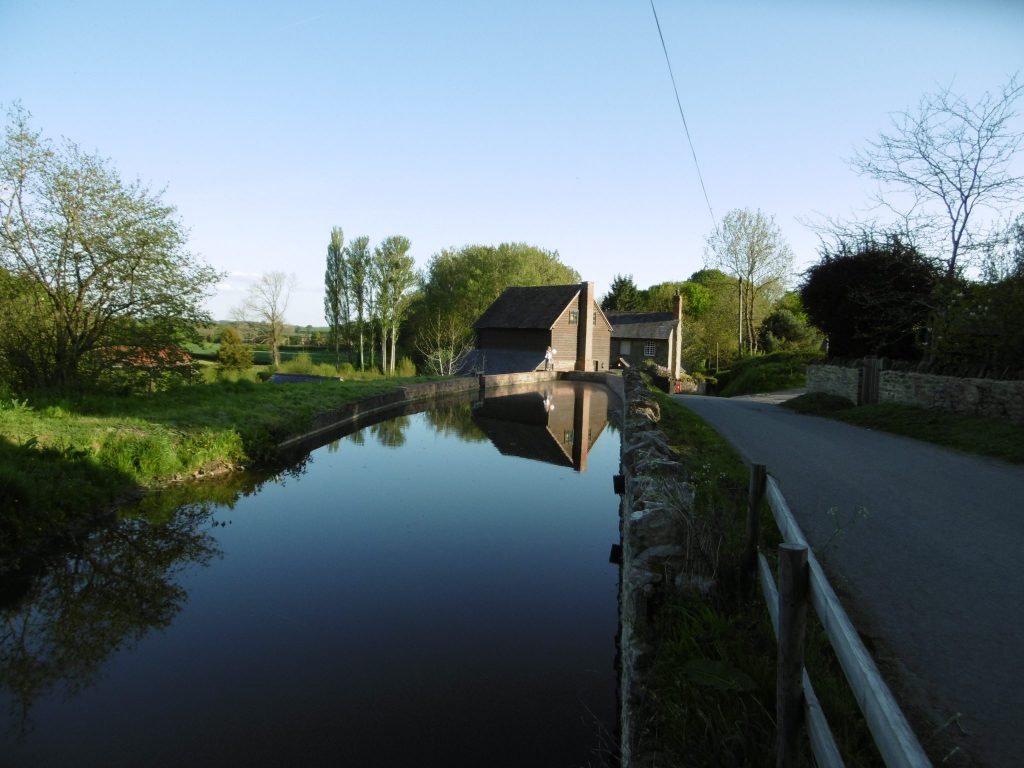
This weekend, the Society for the Protection of Ancient Buildings-Watermills Section holds its annual open weekend for wind and watermills, and we are opening Clencher’s Mill in Eastnor from 10.30am until 12.30pm. Thanks to the support of the SPAB and to funding through Natural England under the Higher Level Stewardship scheme, we have been able to reconnect the old mill machinery and restore the waterwheel ; we expect to be able to test run the mill on Saturday morning, though not to grind flour.
We have more work to do. The mill pond walls have deteriorated in large areas since the water was cut off in the 1920s after a dispute between the miller and farmer where the water was diverted into the leat, but we anticipate a little more grant funding towards their repair. In due course, we would like to lift the mill stones and inspect and recut them as necessary, but that will involve quite a bit of work as Herefordshire mills were not provided with stone hoists. We aim to open the mill when we can and especially to encourage visits by schools. We would like to grind wheat and make flour.
A note by the SPAB (Alan Stoyel) is set out below:
Eastnor has had its watermill since at least the late 13th century, but it was in the 18th century that Clencher’s Mill was rebuilt in its present form. A weather-boarded timber-framed structure on a brick and stone base, it is typical of many local farm buildings. The combination of overgrown former millpond beside the road, pig-sties in the yard behind, and pieces of millstone built into the front wall is evidence of it being a water-powered corn mill. The tall chimney on the building was purely for serving fireplaces on two floors – dispelling the frequently-held misconception that traditional corn mills were in constant danger of explosions from flour dust!
When the mill was constructed it was built in a conventional way, typical of the period, with two pairs of millstones on the first floor, driven from below, by wooden machinery. The massive upright shaft was continued above the stones, to power any other machines required. This, with the crown-wheel at the top, driving the wooden lay-shaft and pinion, is contemporaneous with the building and, together, these constitute an important survival. There would have been belt-driven connections to a sack-hoist in the loft and, formerly, a flour dresser to remove the bran from the ground meal to produce white flour.
The present waterwheel is 16 feet in diameter, larger than usual for Herefordshire. It carries the date of 1820, which makes it the earliest dated example in the county. The wheel is overshot, and was mounted on a wooden shaft originally. The iron machinery driven by the wheel is a replacement from the last quarter of the 19th century. At the same time, or shortly thereafter, the present iron waterwheel-shaft replaced a massive wooden one, and a new sack-hoist was installed in the loft. Following all these improvements it was a relatively short time before flour production ended – during the First World War. The mill then produced only animal feed, and working by water power ceased in the 1920s. It was probably at this time that one of the pairs of stones was removed. About 40 years later use of the mill finally came to an end – by which time it had been powered by a tractor via shafting from the next door building where a cider press and apple scratter were also housed. The water to the mill had been cut off when the miller had a dispute with the upstream tenant at Goldhill farm, a Mr Browning.
The postcode is HR8 1RR. Parking will be in the field below the mill, reached via the gate just before the ford on the western side. Clencher’s Mill is Listed Grade II.
We look forward to seeing visitors from 10.30am on Saturday 11th May.
JH-B 8th May 2013

We are nearly ready to open for the Easter weekend, starting on Good Friday at 11am. We are running our popular Easter Egg Treasure Hunt, which this year extends the egg pun to: Easter mEGGa Hunt, with clues around the castle and grounds giving visitors the chance to win a very large chocolate egg; if consumed too fast, there will be a definite breach of the Government’s healthy eating campaign, but it will be delicious…
Behind the scenes, a lot has to be done before we open the doors. Spring cleaning has to be finished, ropes and signs put up, the DVD for visitors unable to walk up the stairs checked, the dog bowls filled (we welcome dogs in the house with well-behaved owners), items sent away for restoration returned and put in their places. Outside, we have put new gravel in the courtyard and car park, repainted the village signs, restored the lake weir and tidied up the many fallen branches brought down by the earlier snow falls. The tea tables will have been placed in the tea room yard, though it may be a bit chilly for those who normally like to sit outside, and the visitor centre will be clean and ready for action. We have arranged for visitors with Privilege Cards to be fast tracked through the entrance, which should be good for them and shorten any queues. The shop has been restocked, though if this weather continues, the demand for ice cream may not be too high.
The daffodils, if not covered by snow, should be out, and the playground ready for action, with its repaired swing and the Burma bridge, which was very popular last year when it was new. We have planted a lot of young trees in the grounds, something future generations should appreciate if the rabbits and squirrels do not get them first. At least there is no drought at the moment, so they are having a good start.
We hope to have a busy weekend, whatever the weather. My coal-fired traction engine should be in the Courtyard in steam on Easter Day, and a wood fire will greet visitors every day in the Great Hall, giving a genuinely warm welcome in what may be EGGstreme conditions for the time of year…
JH-B 25th March 2013
Last year, under the Higher Level Stewardship scheme, we accepted a grant managed by Natural England to help restore the machinery in Clencher’s Mill, an old water mill on the estate about a mile from the castle. We had maintained the mill building, and the machinery, including the water wheel dated 1820, had luckily remained in situ as opposed to being removed for scrap. The mill had worked with water power until the 1920s, when the miller and the farmer, who farmed the land where the water entered the mill leat, had a row, and the supply was cut. The machinery then was powered by a tractor until the 1940s.

We were encouraged by Alan Stoyel, the local representative of the Society for the Protection of Ancient Buildings-Mills section, who wrote a synopsis of why the mill was important within the Herefordshire context and by the John Masefield High School in Ledbury who wanted to bring students to see the sustainable plant in action as part of the school curriculum. English Heritage was helpful too and an important part of the grant approval process. We were keen to start in the autumn, but the bat survey revealed we were not alone in the mill, so we have had to wait until their hibernation ended before moving in.
We selected Dorothea Restorations the trading company of Wallis Conservation Limited, as they had the experience of our sort of mill and were based not too far away. In the first image, you will see the wheelhouse with a large gap at the top where the water should be held in a pen trough or launder before being released through a sluice onto the overshot wheel. In the second image, you see Zenon Jurkow on the left and Julian Beel on the right, preparing to assemble the new oak boards of the replacement launder.
After being empty for almost 90 years, the pond and leat have needed a lot of additional work, some of which will be funded by the Malvern Hills AONB Sustainable Development Fund. In another blog, I will describe some of what we have had to do to link the pond again with the stream and the regulatory hurdles we have had to cross.
JH-B 11th March 2013

The Big Chill first came to Eastnor in 2001 as a small festival with a dedicated following of fewer than 10,000 fans. It was not a festival that aimed to attract huge crowds to mainstream acts, but rather specialised in up-and-coming performers, including a number of DJs. The festival also had a cinema, poetry area and arts trail, and as we soon discovered, delicious food stalls and some very good shops selling clothes, music etc. The audience mostly camped in fields we made available around the main site which was in the Deer Park.
The licensing authority was generally supportive as they were keen to see an event like this come to Herefordshire and bring the delights of the county to the attention of a wider audience, whilst local people, who were understandably nervous of the possible noise and disruption, were willing to give it as chance, perhaps encouraged by the prospect of free tickets if they lived close enough to be affected. All went well at the first Festival, although the event caterers bought all the bread from the local supermarket on the Saturday morning, which was not popular with regular customers. On the other hand, the organisers also spent several hundred thousand pounds with local suppliers and recruited local students to work on the site during the festival, so the economic benefits were well appreciated.
Over the last ten years, the Big Chill grew bigger, but it kept its relaxed attitude and low-profile security. At its height, it attracted 25,000 festival goers, with a further 5000 working on site. It became an important event in the Herefordshire summer calendar and a useful way for us to fill the Park programme over the month of setting up and dismantling. More famous acts included Leonard Cohen, Lillie Allen and Kanye West when the main stage area was heaving with spectators. The weather never let us down, amazingly, and the Park recovered, free of litter, after a few weeks.
After missing 2012 because of a clash of dates with the Olympics, sadly the Big Chill decided it should close. It had not attracted quite enough visitors and competition in the middle of the summer for the few headline acts every festival needs was too intense.
I am very sad it has gone as it was an exciting event and unfailingly attracted my elder children to come home for the weekend! I understand the tradesmen of Ledbury will miss it too, but we are on the look out for a replacement event…
JH-B 10th February 2013
Ages ago, I saw a programme on Granada TV about Chatsworth and was impressed by everything I saw, but I particularly remember a shot of the house clock winder walking down a long corridor with a large ring of clock keys jangling from a ring. I was slightly surprised that such a house, especially a very large one where a lot of people already worked, needed a clock winder as well.
When we had restored all the clocks (26 in all, excluding the Turret clock described earlier) at Eastnor, I was confident that our house team would be able to do the job or that I could fill in when they were not available. For some of the time, it worked all right. There was a soothing tick-tock in the rooms where the clocks were, and when they reached the hour, there was a satisfying cascade of bells, perfect synchronisation obviously not being possible.
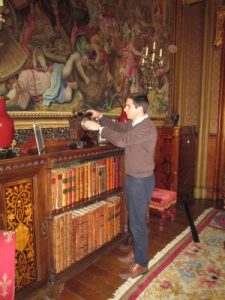
But as our business grew, I noticed that the winding job, quite rightly, was not being given priority over the needs of customers and visitors. Clocks stopped, and sometimes, annoyingly, eleven hours behind the correct time, so it took a while to wind them forward. Going away for an hour to avoid the chore often led to the job being forgotten.
I then accepted that a clock winder was necessary after all. We placed an advertisement in the window of the jewellery shop in Ledbury, Gaynans where Peter Judge, the owner and resident clock and watch repairer, told me he had started his career winding clocks in a big house in Cheshire, so he knew what we needed. There was not an overwhelming response, but luckily Chris Powell, an excellent clock repairer with a workshop on the estate, said he would do it, probably, he said, because he did not want anyone else to.
He started work in the spring, and it has gone very well as he is monitoring performance and making adjustments as he goes along. The image shows Chris at work in the Gothic drawing Room. I hope our guests observe that all our clocks are running as I certainly do.
JH-B 21st December 2012
Our first major restoration project followed the damage caused to our towers by the hurricane in January 1976. The force of the wind blew some of the battlements off the tops of three of them, and there was no option other than to repair them. We managed to get by over the following ten years patching up the roof as we went along, but in 1986, the keep stonework that had suffered from many wet and freezing winters began to show signs of collapse, so we started on a new phase of major work.
My mother instructed Ian Stainburn a local architect based in Ledbury with experience of similarly challenged ecclesiastical buildings and dealing with English Heritage a grant was offered, and work started before there was any serious damage. We then went on to replace crenelations that had been removed from the tops of the four chimney towers, which restored the original appearance of the roofscape in a very satisfactory way. In further phases, we replaced most of the roofs across the rest of the house, using lead where previously short-term, but effective, asphalt had sufficed. We also removed, with some regret because it had been so effective, asbestos cement corrugated sheeting, which had been very low maintenance and invisible behind the parapets, and put slates in its place.
Much of this high-level and high-cost work has been grant aided by English Heritage and, latterly, by the Country Houses Foundation. Although there will always be more to do, we decided, after 25 years during which we had also restored much of the interiors, to apply for a Georgian Group award in the category: Restoration of a Georgian Country House, sponsored by Savills. The timing coincided with Ian Stainburn’s retirement, and at a ceremony held at Christie’s in London; we shared first place with Boconnoc in Cornwall.
We were delighted to have been recognised in this way and with the report in Country Life and the article on 28th November. It has been hard but satisfying work; we hope the house is now in a condition in which it can sustain itself in the future as long as we keep it well maintained.
James Hervey-Bathurst 10th December 2012
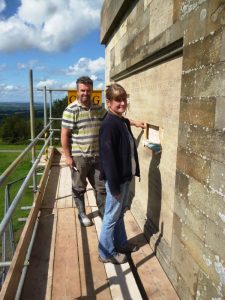 The monument to members of the Somers Cocks, my mother’s family, stands on an outlying hill in the Malverns range, just inside the Eastnor Deer Park. It is visible for miles and is a popular resting place for walkers on the footpath that passes by. The views are long, with Wales in the west, the Cotswolds in the east and the Forest of Dean in the south.
The monument to members of the Somers Cocks, my mother’s family, stands on an outlying hill in the Malverns range, just inside the Eastnor Deer Park. It is visible for miles and is a popular resting place for walkers on the footpath that passes by. The views are long, with Wales in the west, the Cotswolds in the east and the Forest of Dean in the south.
Last year, we repaired damaged stonework and had scaffolding all the way to the top, making the monument look more like a pagoda from a distance. The cost of the work was grant aided by English Heritage and the Country Houses Foundation. The views from the top, if you had the courage to get there, were even better, and last year the weather was better too, so Nimbus Construction enjoyed the job.
This year, we have been re-carving the indistinct lettering and having it blacked with paint to increase legibility. The work is being undertaken by Philippa Fawcett from Bristol and her two assistants, Chris Baker and Richard McPhail. In the image, Philippa is shown with Richard.
Two hundred years ago today, ie 8th October 1812, the son of Lord Somers, Edward Charles Cocks, was serving on Wellington’s staff in the Peninsular War and was killed at the siege of Burgos. His father, who had just started building the castle that April and had already commissioned his architect, Robert Smirke, to build the monument too, immediately dedicated one of the panels on the monument to his son, so it is highly appropriate that we should be returning the elegant and moving words that record his short life to a condition in which all can read them.
JH-B 8th October 2012
When our old house, Castleditch, was demolished in 1814 while the castle was being built, the stables survived and the stable turret clock remained in place. The stables themselves were replaced in 1911, and for some reason the clock was re-sited onto a building next to the estate office, where it ran until the late 1950’s. When we renovated the building in 1990 and converted it for use as the Eastnor Pottery, we removed the turret clock and its tower and rebuilt it over the then castle shop in our tea room yard, but with an electric rather than the original mechanism. But we kept the old clock, its bell and weights.
Then, we were contacted by Chris McKay, an enthusiast and restorer of turret clocks, who saw ours and told us it dated from about 1600. The clock is made from wrought iron, and it was modernised, relatively speaking, in about 1670, when it was converted to pendulum control, an invention that came from Holland. We know this because the pendulum was very short with a very large arc of swing.
At the time the conversion to pendulum was made, the dial was converted to have two hands with the addition of a minute hand. Originally, the clock was situated just behind the original one-handed dial, but the clock must have been moved so it was about five feet below the new dial. In 1938 the clock was restored by Walter Leadbetter of Ledbury.It seems likely that the winding wheels were replaced at that time. Leadbetter has stamped his name on the back of the pendulum bob. The gears behind the dial seem to date from that period as well.
Eastnor Castle clock is a very important historic legacy since it was an old clock that was converted to pendulum very soon after 1670. There are only about 4 or 5 clocks like this in the country. We will find a way to display it in due course so that it can be run when we are open to visitors. It is wonderful to see such an old and simple piece of machinery running, and the tick-tock is quite soothing.
What is the “Titanic” connection? George Leadbetter, father of Walter, was a keen radio man and made his own receiver. On the morning of 15th April 1912 George and Walter (age 15) picked up the Titanic’s CQD (SOS) call. George went round to the police station to report what they had picked up, but they laughed at him in disbelief.
James Hervey-Bathurst, with contribution from Chris McKay – Sept 12
Our summer family events and activities at Eastnor Castle may be a good place to start looking. We know that families need more than our house and grounds to visit, much though I like them myself, so we use them as a backdrop for special events and activities which should appeal to all members of the families and particularly to mothers with children to entertain and preferably tire out during the long summer holiday.
This Sunday (15th July) we have gun dogs at work and ferret racing, which is always highly entertaining, though only private betting is allowed.! From this Sunday, we are open every week, Mondays to Thursdays inclusive, as well as on Sundays until the end of August, when we revert to Sundays only until 30th September.
 From 22nd to 26th July, we have a Children’s Treasure Trail around the grounds, an excellent way to enjoy a hunt among the trees and lawns and take exercise, mental and physical. The following week, from 29th July to 2nd August, we have Explore the Elements-WildPlay, where children explore the elements of earth, wind, fire and water, under supervision, of course. Wind permitting, they should be able to make and fly their own kites, or perhaps run fast enough to make them rise into the sky.
From 22nd to 26th July, we have a Children’s Treasure Trail around the grounds, an excellent way to enjoy a hunt among the trees and lawns and take exercise, mental and physical. The following week, from 29th July to 2nd August, we have Explore the Elements-WildPlay, where children explore the elements of earth, wind, fire and water, under supervision, of course. Wind permitting, they should be able to make and fly their own kites, or perhaps run fast enough to make them rise into the sky.
The rest of August is pretty busy too, with:
* All the Fun of the Circus (without having to run away and join one), where you can try your hand at circus activities, including tight rope walking, at low levels
* Roald Dahl’s The Twits will be performed on Sunday 12th August at 3pm-book now
* The Eastnor Flying Potter will lead the making of fantastic clay creations from 12th-16th August
* On 19th August, we have the Church Fête with jazz musicians on the Valley Lawn
* From 20th-23rd August, WildPlay are back with PlayWild, outdoor activities with a camp fire, den building etc
* Over the August Bank Holiday weekend (Sunday 26th and Monday 27th), we have Animal Adventures, mixed in with a falconry display and ride on a road train.
* We finish the holidays with Summer Sunday Fun, with traditional lawn games and the Valley Lawn zip wire in action.
If more than one of these appeal to you, perhaps our Family Privilege Pass (£58 for 2 adults and three children) would be a sensible investment, though it excludes “The Twits”. We expect the events to carry on even if the weather is bad, and some are in tents anyway, but be prepared for rain unless the jet stream has shifted by then.
JH-B 13th July 2013